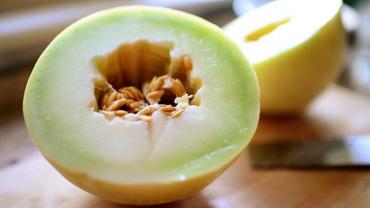
People watching their carbohydrate intake generally gravitate toward berries. Berries are rich in antioxidants and beneficial polyphenols and they deliver nutrients while having a low glycemic impact. Regarding other fruits fructose fearmongering has led people to avoid apples grapes and bananas.
But what about melons? Melons are juicy delicious and supremely refreshing on a hot summer day. And the good news is there’s plenty of room for melon in a healthy diet.
The Cucurbitaceae botanical family includes cantaloupe and honeydew cucumbers watermelon pumpkin zucchini and other squashes gourds and melons. There’s muskmelon Galia melon Crenshaw melon and more. Let’s take a closer look at the two most commonly found in North American supermarkets: cantaloupe and honeydew.
Cantaloupe isn’t that big a nutritional rock star but it definitely fits the bill for a sweet and refreshing treat that won’t wreck blood sugar and insulin levels. A large wedge (about 1/8 of a melon or 102g) provides just 9 grams of carbohydrate. There isn’t a whole lot of fiber in cantaloupe but with only 9 grams of total carbs in a generous serving this isn’t a high-carb indulgence. Cantaloupe has appreciable amounts of vitamin C and potassium and it’s high in the same carotenes that give carrots and sweet potatoes their bright orange color.
Honeydew has less carotene than cantaloupe but like its melon cousin it’s a source of potassium and vitamin C. It’s slightly higher in sugar—about 10 grams net carbs for a large wedge but still not really enough to warrant avoiding if you’re carb-conscious. There’s an interesting difference in the composition of the sugars in these two melons though. Cantaloupe contains about 55% sucrose 19% glucose and 24% fructose. Honeydew is a bit lower in sucrose and higher in the monosaccharides: it’s about 30% sucrose with 33% glucose and 36% fructose. Overall though considering their low total carbohydrate content both fruits are relatively low in fructose and the small amounts of fructose we get from a reasonable amount of fruit in our diets isn’t reason for alarm. Certainly excess fructose consumption is a problem for many people but with the exception of those who drink large amounts of juice the worrisome fructose overload in the modern diet comes mostly from sugar-sweetened beverages and sugary foods in general—not from the occasional wedge of fresh melon.
Other than being delicious do these melons offer any potential benefits for health? Oddly enough cantaloupe is high in the critical antioxidant enzyme superoxide dismutase (SOD). Supplementation with a melon-derived SOD was shown to improve insulin sensitivity and vascular function in animals and to reduce physical and mental fatigue in humans. Liposomal formulations of SOD seem to help protect it from proteolytic degradation in the stomach. Another form that survives gastric acidity is melon SOD coated in wheat gliadin. (Yes that wheat gliadin.) According to researchers “Because SOD is a high-molecular-weight protein absorption at the small intestine is unlikely. Although gliadin activated a tight-junction regulating protein that could increase intestinal permeability there is no evidence to support the ability of SOD to cross the intestinal barrier.” So the gliadin could potentially loosen the tight junctions but the SOD is not likely to permeate into the bloodstream that way. Nevertheless to get some SOD from melon maybe it’s best to just eat melon!
And there are plenty of ways to do that. Cantaloupe and honeydew are both delicious consumed all by themselves or you can make your guests feel special by wrapping cantaloupe wedges in thin slices of salty fatty prosciutto. Add some figs and goat cheese for a stunning and satisfying salad that checks all the boxes: sweet savory salty acidic fatty. Speaking of fat since the carotenes in cantaloupe are better absorbed when consumed along with a bit of fat this salad that pairs cantaloupe with avocado and an olive oil-based dressing is a good strategy. Melon salsa with cantaloupe honeydew and watermelon is as pretty as it is refreshing—a sure winner for warm weather cookouts. For something on the savory side this unique cantaloupe gazpacho with shallots garlic and basil is certainly outside the ordinary or try curried pork chops with a cooling side of honeydew and cucumber. For those who prefer to sip their cantaloupe this shake with cantaloupe lime and toasted coconut will hit the spot or a cucumber melon white sangria could be the hit of your next party.